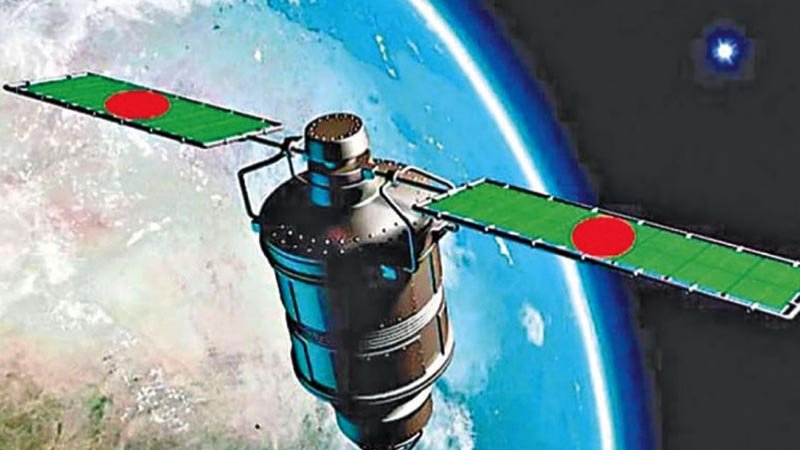Bangabandhu Satellite’s commercial operation begins next week


Bangabandhu Satellite-1 (BS-1), the country’s first geostationary communications and broadcasting satellite, is going into commercial operation next week.
The satellite, which was launched into the orbit on 12 May 2018, has stepped into the second year of its operation today. BCSCL chairman Dr Shahjahan Mahmood told Bangladesh Post as Prime Minister Sheikh Hasina was abroad, they had to defer the anniversary programme to May 19.
At the programme, the Prime Minister will hand over broadcasting certificates to the country’s local television channels through which commercial activity of the satellite will officially be inaugurated, he added. It is to be noted, BS-1 made agreement with the country’s almost every satellite television channel to transmit. To this end, Shahjahan said, from that day (May 19) all television channels will start broadcasting through the BS-1.
‘The TV channels will purchase bandwidth as they purchased before, they will pay $2000 for per megahertz bandwidth. Each television requirement is four to six megahertz’, he further said. Besides, BCSCL is also working to bring online money transaction through ATM booth under its shed. During the anniversary programme, it is scheduled that, the prime minister will experimentally connect an ATM booth of Dutch Bangla Bank Limited using the BS-1 bandwidth.
‘ATM booth operation using BS-1 experimentally is successful. Gradually all ATM booths will come under BS-1 without any broadband connection. This will reduce the threat to cyber security’, Shahjahan further added.
During the anniversary, some documentaries on Bangabandhu Satellite will be displayed where cyber security in online money transaction, bringing all television channels under its shed, internet and tele-medicine to remote islands and DTH will be highlighted. The satellite will be able to provide 40 different types of services. With a capacity of 1,600 megahertz, the satellite will have 40 physical transponders, of which 20 will be kept reserved for Bangladesh's own needs, and the rest rented out to earn foreign revenue. One transponder is equivalent to 36 MHz.
Internet bandwidth is another product of Bangabandhu-I, out of the satellite's 40 transponders have a total 1,600 MHz frequency, 26 of them in KU band and 14 in C-band. BCSCL already signed a MoU with the Shipping Ministry on July 8 last year. With this agreement 35,000 local and foreign ships will receive satellite services from Bangabandhu-1 for their safe journey at sea and local river channels.
Indonesia and the Philippines have shown interest to purchase bandwidth form BS-1, besides the satellite will be used to provide internet service to char areas. Including the enclaves, 40 remote areas, islands including Shilar Char, Char Suresh, Saint Martin and other islands of the country will get internet facility through the Bangabandhu Satellite.
Meanwhile, the Fisheries Department has taken steps to monitor the fishing vessels in Bay of Bengal through Bangabandhu satellite. Under the Bangladesh Sustainable Coastal Marine Fisheries Project BSCMFP, with World Bank assistance, around 10,000 vessels will come under direct supervision through Very Small Aperture Terminal (VSAT) technology of the satellite soon.
Officials of Directorate of Fisheries DoF said the process is underway to sign an agreement with Bangladesh Communication Satellite Company Ltd BCSCL, sales and maintenance out let of Bangabandhu Satellite-1, country’s first satellite in orbit. BSCMEP, a five year duration project of TK 1868.88-crore with main objective to fisheries stock management in Bay of Bengal, marine aqua culture development, livelihood security and human resource development of the sector, started in January.
Abul Hasnat, Director of Marine Fisheries Department said, “To monitor the fishing vessels in sea is essential now as the lack of information hampers marine fisheries management. The Bangabandhu satellite- 1 brings the opportunity to us to monitor all vessels easily.” “We are going to introduce Vessel Monitoring System VMS and Automatic Identification System AIS, modern technologies for tracking in sea, where VMS for industrial trawlers and AIS for mechanized and non-mechanized boat initially 10,000 vessels will get required instruments for such connection under BSCMF project, he said.
“The government is working to finalize marine fisheries policy, so that every vessel should enter into communication setup to be ensured, he also said.
Bangladesh entered the elite Space Club of 57 nations with the launch of its first geostationary communications satellite, Bangabandhu-1, into orbit by US space transport company SpaceX on May 12, 2018.
MFD source said, 15-20% of the production of marine fisheries is in the 250 industrial trawlers. The other 80 percent is through artisanal fishing by more than 50,000 mechanized and non- mechanized boats. A Joint Coordination Centre (JCC), coordinated by the DoF and connecting other relevant marine and coastal authorities, will be established to coordinate domestic vessel monitoring, patrolling, and information-sharing for improved reporting, search and rescue, and enforcement.
The project will support the design, purchase and installation of physical and communications infrastructure, provision of licenses, and technical assistance and services for capacity development and training, as well as development of protocols and guidance manuals for information-sharing and division of Responsibilities among DoF and the other JCC agencies.
Project funds for above, will be further directed for design, deployment and training for the integrated Monitoring control and Surveillance MCS coverage for improving safety of life at sea and effective fisheries management. This will allow upgrading and providing 100% coverage to the industrial fleet’s Vessel Monitoring System (VMS), including software, hardware, and transponders, and will introduce Automatic Identification System (AIS)4 or compatible units for the artisanal fleet.
The AIS, in particular, is expected to significantly improve search and rescue capabilities, which are becoming critical for hundreds of thousands of artisanal fishermen as increased climate variability and change lead to more and more extreme weather events in the Bay of Bengal. The project will further support integration of the AIS and VMS with the Fishers’ ID and vessel databases, as well as with the land-based catch monitoring system supported under sub-component.
Bakhtiar Ahamed, assistant general manager (Sales and Engineering of BCSCl) said, preliminary discussion with DOF has been done to provide the connection, now they are working to install a communication hub and other infrastructure and upgrading the vessels for such activity.” If everything is okay, the final decision will be made for monitoring all types of fishing vessels from Bangabandhu Satellite with VSAT technology, he said.
Of all the fishing vessels in the Bay of
Bengal, only 250 industrial trawlers have contract at coast through tele communication system of Bangladesh Navy. Now Bangladeshi vessels are fishing only at the maximum depth of 200 meters in the Bay of Bengal, The area is only 32,440 SQ KM whereas the country's sea territory is 118,813 SQ KM. Bangladesh is included as a pilot country of the Blue-Economy which is considered a key factor to achieve UN-declared 'Sustainable Development Goals'.
Currently, around 32,500 mechanized artisanal boats and almost the same number of non- mechanized boats is fishing in the Bay of Bengal. Bangladesh is the third largest fish producing country in the world, with annual production of about 38 lakh tonnes. Of this, 17 percent is collected from the sea. Fisheries extraction of the country in the Bay of Bengal was 6.54 lakh tonnes in 2017-18.
Measures have been taken to boost marine fisheries. The Research ship RV Meen Shandhani has been operating in the sea for collecting information and data for the new fisheries ground in Bay of Bengal since 2016. Authority is expecting after the result of the survey is published, more vessels will move to catch fish in the Bay. Under the BSCMFP, DoF is going to establish more surveillance check posts and Fish landing and processing centers along the coast.



